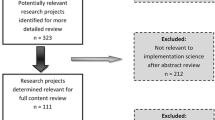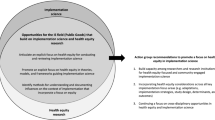Abstract
There has been a recent surge of eHealth programs in cancer and other content areas, but few reviews have focused on the methodologies and designs employed in these studies. We conducted a systematic review of studies on eHealth interventions on cancer prevention and control published between 2001 and 2010 applying the Pragmatic Explanatory Continuum Indicator Summary (PRECIS) criteria and external validity components from the Reach Effectiveness Adoption Implementation Maintenance (RE-AIM) framework. We identified 113 studies that focused on cancer prevention and control of eHealth interventions. Most studies fell midway along the explanatory/pragmatic trial continuum, but few reported on various practical feasibility criteria for translation. Despite vast interest in cancer eHealth and the applied nature of this field, few studies considered key external validity issues. There is a need for use of alternative pragmatic study designs and transparent reporting of external validity components to produce more rapid and generalizable results.

Similar content being viewed by others
References
Eheman C et al. Annual report to the nation on the status of cancer, 1975–2008, featuring cancers associated with excess weight and lack of sufficient physical activity. Cancer. 2012; 118(9): 2338-66.
Chu, K.C., B.A. Miller, and S.A. Springfield, Measures of racial/ethnic health disparities in cancer mortality rates and the influence of socioeconomic status. J Natl Med Assoc, 2007. 99(10): p. 1092–100, 1102–4.
Saldana-Ruiz, N., et al., Fundamental causes of colorectal cancer mortality in the United States: understanding the importance of socioeconomic status in creating inequality in mortality. Am J Public Health, 2012.
Noar SM, H.N., eHealth Applications: Promising Strategies for Behavior Change, Routledge, NY, 2012.
Bennett GG, Glasgow RE. The delivery of public health interventions via the internet: actualizing their potential. Annu Rev Public Health. 2009; 30: 273-92.
Strecher V. Internet methods for delivering behavioral and health-related interventions (eHealth). Annu Rev Clin Psychol. 2007; 3: 53-76.
Wantland DJ et al. The effectiveness of web-based vs. non-web-based interventions: a meta-analysis of behavioral change outcomes. J Med Internet Res. 2004; 6(4): e40.
Murray E et al. Interactive health communication applications for people with chronic disease. Cochrane Database Syst Rev. 2005; 4: CD004274.
Glasgow RE. eHealth evaluation and dissemination research. Am J Prev Med. 2007; 32(5 Suppl): S119-26.
Eysenbach G. CONSORT-EHEALTH: improving and standardizing evaluation reports of web-based and mobile health interventions. J Med Internet Res. 2011; 13(4): e126.
Zwarenstein M et al. Improving the reporting of pragmatic trials: an extension of the CONSORT statement. BMJ. 2008; 337: a2390.
Thorpe KE et al. A pragmatic–explanatory continuum indicator summary (PRECIS): a tool to help trial designers. J Clin Epidemiol. 2009; 62(5): 464-75.
Riddle DL et al. The pragmatic–explanatory continuum indicator summary (PRECIS) instrument was useful for refining a randomized trial design: experiences from an investigative team. J Clin Epidemiol. 2010; 63(11): 1271-5.
Selby P et al. How pragmatic or explanatory is the randomized, controlled trial? The application and enhancement of the PRECIS tool to the evaluation of a smoking cessation trial. BMC Med Res Methodol. 2012; 12: 101.
Glasgow RE et al. Applying the PRECIS criteria to describe three effectiveness trials of weight loss in obese patients with comorbid conditions. Health Serv Res. 2012; 47(3 Pt 1): 1051-67.
Koppenaal T et al. Pragmatic vs. explanatory: an adaptation of the PRECIS tool helps to judge the applicability of systematic reviews for daily practice. J Clin Epidemiol. 2011; 64(10): 1095-101.
Eng TR. The eHealth Landscape: A Terrain Map of Emerging Information and Communication Technologies in Health and Health Care. Princeton: Robert Wood Johnson Foundation; 2001.
Rabin BA, G.R., Dissemination of interactive health communication programs, in Interactive Health Communication Technologies: Promising Strategies for Health Behavior Change: Routledge, NY, 2012.
Khoury MJ, Gwinn M, Ioannidis JP. The emergence of translational epidemiology: from scientific discovery to population health impact. Am J Epidemiol. 2010; 172(5): 517-24.
Hiatt RA, Rimer BK. A new strategy for cancer control research. Cancer Epidemiol Biomarkers Prev. 1999; 8(11): 957-64.
Glasgow RE, Vogt TM, Boles SM. Evaluating the public health impact of health promotion interventions: the RE-AIM framework. Am J Public Health. 1999; 89(9): 1322-7.
Pagliari C. Design and evaluation in eHealth: challenges and implications for an interdisciplinary field. J Med Internet Res. 2007; 9(2): e15.
Glasgow RE, Chambers D. Developing robust, sustainable, implementation systems using rigorous, rapid and relevant science. Clin Transl Sci. 2012; 5(1): 48-55.
Glasgow RE et al. Disseminating effective cancer screening interventions. Cancer. 2004; 101(5 Suppl): 1239-50.
Bennett, G., eHealth and D&I research: what next?, in Training Institute for Dissemination and Implementation Research in Health. July 9–13, 2012.
Greene SM, Reid RJ, Larson EB. Implementing the learning health system: from concept to action. Ann Intern Med. 2012; 157(3):207-10.
Collins LM, Murphy SA, Strecher V. The multiphase optimization strategy (MOST) and the sequential multiple assignment randomized trial (SMART): new methods for more potent eHealth interventions. Am J Prev Med. 2007; 32(5 Suppl): S112-8
Riley WT et al. Health behavior models in the age of mobile interventions: are our theories up to the task? Transl Behav Med. 2011; 1(1): 53-71.
West JH et al. There's an app for that: content analysis of paid health and fitness apps. J Med Internet Res. 2012; 14(3): e72.
Abroms LC et al. iPhone apps for smoking cessation: a content analysis. Am J Prev Med. 2011; 40(3): 279-85.
Acknowledgments
The preparation of this manuscript was partially funded through the National Cancer Institute Centers of Excellence in Cancer Communication Research (award number P20CA137219). This project has been funded, in whole or in part, with federal funds from the National Cancer Institute, the National Institutes of Health, under contract no. HHSN261200800001E. The content of this publication does not necessarily reflect the views or policies of the Department of Health and Human Services, nor does it mention of trade names, commercial products, or organizations implying endorsement by the US government. The opinions expressed are those of the authors and do not necessarily reflect those of the National Cancer Institute.
Author information
Authors and Affiliations
Corresponding author
Additional information
Implications
Practice: Practitioners should look for and expect research reports to provide transparent information to make it possible to determine whether an eHealth program is possible to implement in their setting.
Policy: eHealth journals and grant funding organizations should encourage more transparent reporting on issues related to translation and external validity.
Research: Researchers should more consistently report on PRECIS criteria and other factors related to translation.
About this article
Cite this article
Sanchez, M.A., Rabin, B.A., Gaglio, B. et al. A systematic review of eHealth cancer prevention and control interventions: new technology, same methods and designs?. Behav. Med. Pract. Policy Res. 3, 392–401 (2013). https://doi.org/10.1007/s13142-013-0224-1
Published:
Issue Date:
DOI: https://doi.org/10.1007/s13142-013-0224-1




